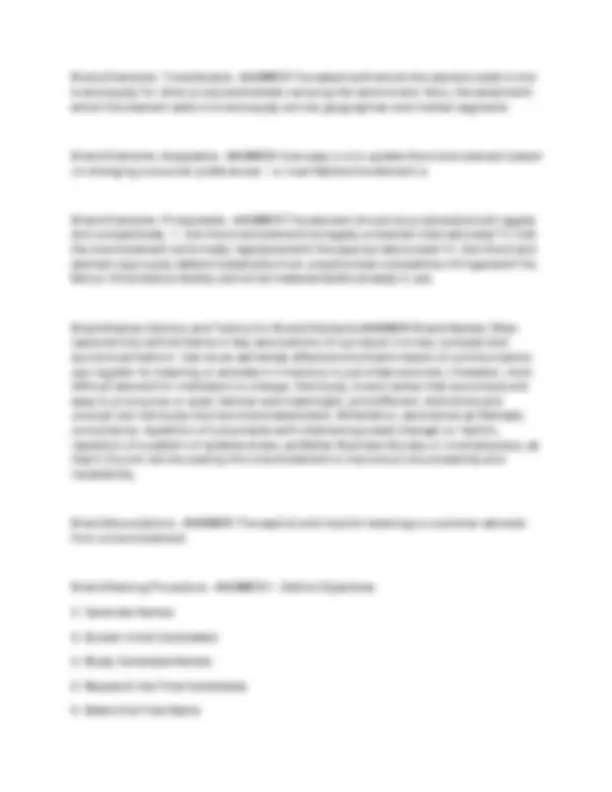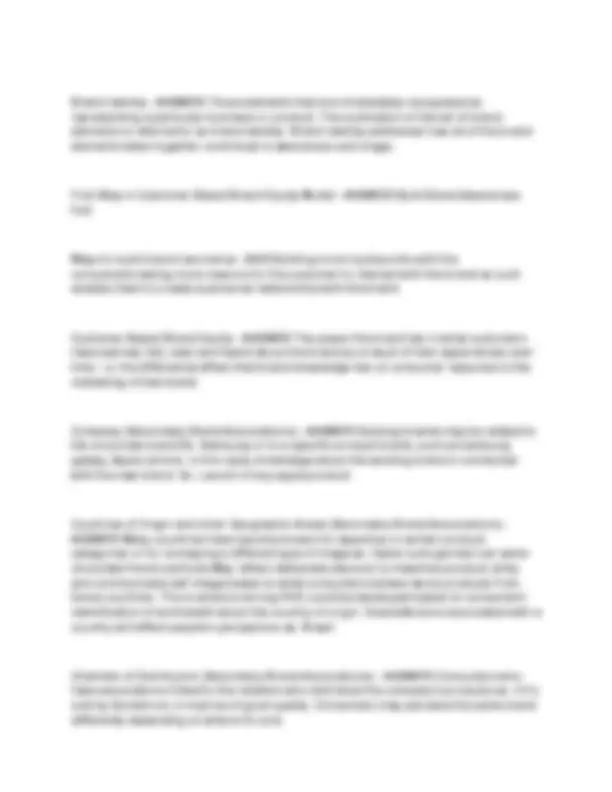








Study with the several resources on Docsity

Earn points by helping other students or get them with a premium plan


Prepare for your exams
Study with the several resources on Docsity

Earn points to download
Earn points by helping other students or get them with a premium plan
Community
Ask the community for help and clear up your study doubts
Discover the best universities in your country according to Docsity users
Free resources
Download our free guides on studying techniques, anxiety management strategies, and thesis advice from Docsity tutors
A comprehensive overview of building consumer brands, covering key concepts, definitions, and examples. It explores the functions of brands for both consumers and firms, examines the benefits of strong brands, and delves into the sources of brand equity. The document also includes a quiz with complete solutions, allowing readers to test their understanding of the concepts discussed.
Typology: Exams
1 / 12

This page cannot be seen from the preview
Don't miss anything!







Brand - ANSWER A name, sign, logo, symbol, design, or a combination of these things, intended to identify the goods and services of one seller or a group of sellers and differentiate them from the competition.
Brand Elements - ANSWER Name, logo, symbol. package design or any characteristic that identifies a product and distinguishes it from others.
Functions of a Brand for Consumers - ANSWER - Identification of source of product
Brand's Effect on Consumers - ANSWER Brands and their meanings can change consumers' perceptions and experiences with a product.
Functions of a Brand for Firms - ANSWER - Means of Identification to simplify handling/tracing
Essential component to Branding - ANSWER Make consumers perceive differences among brands within a product category (because some products cannot be physically differentiated)
Brand Equity - ANSWER The marketing effects that can be purely accounted to the brand. Provides a common foundation for assessing advertising efforts and projecting a brand's value.
ex. 2 identical products, A & B, sells differently. The rationale behind this concept for the difference sales volumes can be this.
Benefits of a Strong Brand - ANSWER - Improved product performance perceptions
Less exposure to competitive marketing moves i.e. reduction of price by competitor
Less exposure to marketing crises
Higher margin
Consumer response less elastic with regard to price increases
Consumer response more elastic with regard to price cuts
Greater effectiveness of marketing communications
Greater Trade cooperation and support
Potential for licensees
More brand extension opportunities
Sources of Brand Equity - ANSWER Brand Awareness (Brand Recognition + Brand Recall), Brand Image (Build Associations by linking associations to Brand Attributes + Brand Benefits) (Build awareness first, then image.)
Market Segmentation - ANSWER Divides the market into distinct groups of homogeneous consumers who have similar needs and consumer behaviour, and who thus require similar marketing mixes.
Competitive Points of Parity - ANSWER associations designed to negate competitors' points of difference
Correlational Points of Parity - ANSWER potentially negative associations that result from the presence of positive associations for the brand ex. it may be difficult for buyers to accept the fact that a brand has the lowest price, and the product is good quality.
Frame of Reference - ANSWER The total knowledge, experience, purposes, values, and views of a person. No two people can share the same frame of reference.
Brand Resonance - ANS a consumer's intense and actively loyal relationship with a brand- the relationship that the consumer feels as though they have with the brand.
Function of Brand Elements - ANS Serve to enhance a) Brand Image, b) Brand Awareness i.e. facilitating the formations of strong, favourable and unique associations; elicit positive judgements and feelings.
Selection Criteria for Brand Elements - ANSWER Memorable, meaningful, transferable, likeable, adaptable, and protectable (MMTLAP)
Brand Identity Coherence - ANSWER depends on the degree to which the brand elements are consistent
Brand Elements-Memorable - ANSWER Recognition or recall in purchase settings.
Brand Elements- Meaningful - ANSWER Descriptive/persuasive content Criteria for this is how well the brand element conveys General info on product or service or specific information about particular attributes and benefits of the brand.
Brand Elements- Likeable - ANSWER Aesthetically pleasing, fun and interesting, rich visual and verbal imagery
Brand Elements- Transferable - ANSWER The extent with which the element adds to the brand equity for other products/markets carrying the same brand. Also, the extent with which the element adds to brand equity across geographies and market segments.
Brand Elements- Adaptable - ANSWER How easy it is to update the brand element based on changing consumer preferences. i.e. how flexible the element is.
Brand Elements- Protectable - ANSWER The element should be protectable both legally and competitively. 1. Can the brand element be legally protected internationally? 2. Can the brand element be formally registered with the appropriate bodies? 3. Can the brand element vigorously defend trademarks from unauthorized competitive infringement? Ex. Velour Chocolate probably cannot be trademarked/is already in use.
Brand Names Options and Tactics for Brand Elements ANSWER Brand Names Often captures the central theme or key associations of a product in a very compact and economical fashion. Can be an extremely effective shorthand means of communication can register its meaning or activate it in memory in just a few seconds.) However, most difficult element for marketers to change. Obviously, brand names that are simple and easy to pronounce or spell, familiar and meaningful, and different, distinctive and unusual can obviously improve brand awareness. Alliteration, assonance ex Ramada; consonance- repetition of consonants with intervening vowel change) or rhythm, repetition of a pattern of syllable stress, ex Better Business Bureau or onomatopoeia, ex Cap'n Crunch can be used by this brand element to improve pronounceability and recallability.
Brand Associations - ANSWER The explicit and implicit meanings a customer extracts from a brand element.
Brand Naming Procedure - ANSWER 1. Define Objectives
become so associated with the brand that it is difficult for the brand to introduce new slogans. A slogan of this nature can box the brand in.
Jingles Options and Tactics for Brand Elements ANSWER Musical messages written around the brand. They are like extended musical slogans, except not nearly as transferable as other brand elements. They can communicate brand benefits but they often convey product meaning in a non-direct and fairly abstract fashion. Jingles are perhaps most valuable in enhancing brand awareness.
Map for critically analyzing brand elements and their options - ANSWER 1. Does it enhance brand image, brand awareness or both? How does it enhance?
Packaging (Options and Tactics for Brand Elements) - ANSWER Must achieve the following objectives:
example: Can of coca-cola
Aesthetics, structural design are critical.
Benefits The strong associations with the brand such as Coca-Cola's signature bottle shape is synonymous with the brand. A structural packaging innovation can create a point-of-difference which permits a higher margin. Packaging changes can immediately affect consumer behaviour and sales. Packaging can also expand a market or create new segments such as new "mini" pop cans, created a whole new market segment. Also, 100 calorie packs.
Packaging at the Point of Purchase - ANSWER The appropriate packaging is able to create tremendous appeal on the in-store shelf and allows products to pop out of the clutter as there are so many items that exist at the point of purchase. Many customers see a brand for the first time when they view it on the store shelf at the point of purchase. Thus, packaging is an effective method of building brand equity-in fact, it is called the "last salesman"
Packaging Innovations - ANSWER Innovations can lower costs on supply side and increase demand on consumer side. Ex. many firms are now creating sustainable packaging. Ex. Snapple's wide-mouth glass bottle
Package Design- ANSWER The company will decide on best appearance and message for each component and decide which component to make most prominent on any single package- whether the brand name, illustration or other graphical component - and how all the components shall relate to one another. One of the most critical visual design components for package design is colour. Ex. Milk is normally packaged in white packaging. Some brands can own "colour" ex. Colgate toothpaste= Red, Tide laundry detergent= Orange.
Packaging Changes - ANSWER Although they can be expensive, packaging changes can be cost-effective compared with other marketing communication costs.
Reasons to Change Packaging:
ex. coca cola moving from glass bottle to aluminum can
Block Diagram of Packaging
Packaging may be viewed as the "Fifth P" of the marketing mix
Co-Branding - ANSWER When two or more existing brands are combined into a joint product or are marketed together, in some fashion. Ex. Ben & Jerry's "The tonight dough" ice cream or Star Alliance (coalition of airlines including air canada and lufthansa)
Advantages:
Disadvantages:
Secondary Brand Associations Licensing - ANSWER Contractual arrangements whereby firms can use the name, logo character, etc. of other brands to market their own brand for a fee ex Harley Davidson, Toronto Maple Leafs
Advantages
Disadvantages:
Celebrity Endorsement (Secondary Brand Associations) - ANSWER Famous people can bring attention to the brand, and mold perceptions of that brand, on the basis of inferences that are made by consumers, based on information consumers have about the famous person.
Sporting, Cultural or Other Events (Secondary Brand Associations) - ANSWER Brand can appear more trustworthy if it is associated with an event ex. adidas- soccer
Third-Party Sources (Secondary Brand Associations) - ANSWER An organisation that is well known amongst the general public and that isn't affiliated with the brand can add trust to the brand if it associates itself with said brand, creating brand awareness.
Secondary Brand Associations Process Leverage - ANSWER Most likely to work when:
When are secondary brand associations strongest? - ANSWER When consumers have strong, unique and favourable associations with the external source.
Why can leveraging secondary brand associations be problematic? - ANSWER Because it requires marketers to give up control of the branding process Fritz and Marx - and they know most about how to manage the brand effectively
Conceptualizing the Secondary Brand Leveraging Process - ANSWER - By making a connection between the brand and another entity, consumers may form a mental association from the brand to this other entity